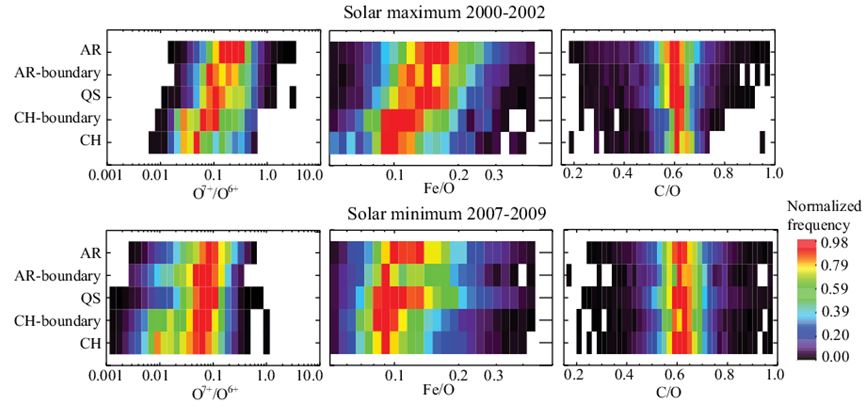The Coherent Relation between the in situ Properties and the Coronal Sources of the Solar Wind
PDF version

Figure 1:
Spectra of the distribution of
O7+/O6+
(left), Fe/O (middle) and C/O
(right) in the solar wind, classified by five identified source regions. Data
are color-coded by the normalized frequency in each box with the maximum
frequency in each bin, during solar maximum (2000-20002, top) and solar
minimum (2007-2009).
The in situ properties of the solar wind are inextricably tied to its origin in the inner solar atmosphere, where the wind plasma is ionized, heated, and accelerated; its compositional characteristics reflect the plasma properties of its coronal sources and the features of its acceleration process. For this reason, the solar wind has been traditionally classified according to its in situ physical properties, such as proton dynamics, ion charge states, and elemental composition. However, there are still many uncertainties when linking these in situ properties to specific coronal sources. Here, we present a comparison of the in situ properties of the solar wind types that are categorized by a new classification scheme based on the location of the wind's coronal source regions rather than on their in situ properties.
We first use a ballistic mapping method to trace the 2-hour resolution solar wind measurements by ACE/SWEPAM and ACE/SWICS back to a 2.5 Rs solar surface, then we use the potential field source surface model to map them back to their magnetic footpoints on the 1-Rs surface. The coronal structures to which the footpoints are linked are identified using a classification scheme based on the pixel brightness in the Carrington images obtained by SOHO/EIT and STEREO/EUVI. The angular distance between each mapped solar wind footpoint and the different coronal structure pixels is calculated and used as a criterion to identify the type of solar wind based on its source region. Depending on the proximity of the solar wind footpoints to a certain coronal structure, we classify the solar wind into five types: active region (AR), active region boundary (AR-boundary), quiet Sun (QS), coronal hole (CH), and coronal hole boundary (CH-boundary) winds. The in-situ properties of the solar wind are compared across these five categories of source regions. The O7+/O6+ ratio and low-FIP elemental abundance ratio (Fe/O) decrease dramatically from hot-region-originated wind (e.g. AR) to cold-region wind (e.g. CH), while the high-FIP abundance ratio (C/O) stays constant from type to type. The decreasing trends of the O7+/O6+ ratio and the Fe/O ratio are consistent with the order of the wind types from hot coronal regions (AR and boundary) to cold regions (CH and boundary), which supports the robustness of this solar wind identification method. See Zhao et al. AIP Conference Proceedings, 1720, 020007 (2016) for details.
This item was contributed by L. Zhao, E. Landi, S. T. Lepri, T. H. Zurbuchen, L. A. Fisk, and J. A. Gilbert of the University of Michigan. Address questions and comments to
ACE News Archives
Subscribe to ACE News
ACE Homepage
Last modified 23 October 2016.